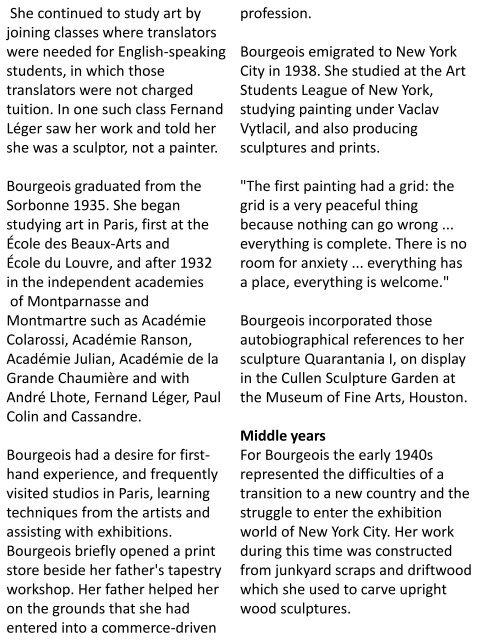Aziz Art January 2019
History of art(west and middle east)- contemporary art ,art ,contemporary art ,art-history of art ,iranian art ,iranian contemporary art ,famous iranian artist ,middle east art ,european art
History of art(west and middle east)- contemporary art ,art ,contemporary art ,art-history of art ,iranian art ,iranian contemporary art ,famous iranian artist ,middle east art ,european art
You also want an ePaper? Increase the reach of your titles
YUMPU automatically turns print PDFs into web optimized ePapers that Google loves.
She continued to study art by<br />
joining classes where translators<br />
were needed for English-speaking<br />
students, in which those<br />
translators were not charged<br />
tuition. In one such class Fernand<br />
Léger saw her work and told her<br />
she was a sculptor, not a painter.<br />
Bourgeois graduated from the<br />
Sorbonne 1935. She began<br />
studying art in Paris, first at the<br />
École des Beaux-<strong>Art</strong>s and<br />
École du Louvre, and after 1932<br />
in the independent academies<br />
of Montparnasse and<br />
Montmartre such as Académie<br />
Colarossi, Académie Ranson,<br />
Académie Julian, Académie de la<br />
Grande Chaumière and with<br />
André Lhote, Fernand Léger, Paul<br />
Colin and Cassandre.<br />
Bourgeois had a desire for firsthand<br />
experience, and frequently<br />
visited studios in Paris, learning<br />
techniques from the artists and<br />
assisting with exhibitions.<br />
Bourgeois briefly opened a print<br />
store beside her father's tapestry<br />
workshop. Her father helped her<br />
on the grounds that she had<br />
entered into a commerce-driven<br />
profession.<br />
Bourgeois emigrated to New York<br />
City in 1938. She studied at the <strong>Art</strong><br />
Students League of New York,<br />
studying painting under Vaclav<br />
Vytlacil, and also producing<br />
sculptures and prints.<br />
"The first painting had a grid: the<br />
grid is a very peaceful thing<br />
because nothing can go wrong ...<br />
everything is complete. There is no<br />
room for anxiety ... everything has<br />
a place, everything is welcome."<br />
Bourgeois incorporated those<br />
autobiographical references to her<br />
sculpture Quarantania I, on display<br />
in the Cullen Sculpture Garden at<br />
the Museum of Fine <strong>Art</strong>s, Houston.<br />
Middle years<br />
For Bourgeois the early 1940s<br />
represented the difficulties of a<br />
transition to a new country and the<br />
struggle to enter the exhibition<br />
world of New York City. Her work<br />
during this time was constructed<br />
from junkyard scraps and driftwood<br />
which she used to carve upright<br />
wood sculptures.

















